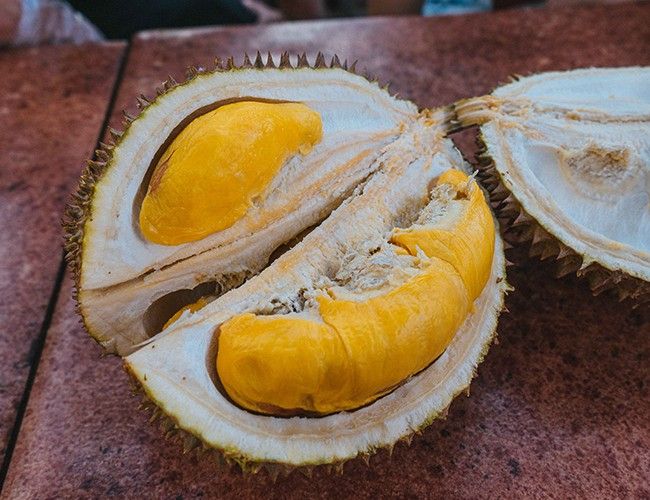

A Chance
How to choose a Durian and not get Ripped Off
Words & images by Sofia Levin
Last updated 18.02.2022
The stench has been likened to old socks and dead bodies. Anthony Bourdain once said that durian makes your breath smell like you’ve been “French-kissing your dead grandmother”. But there's a reason durian remains a prized fruit – it's bloody delicious. Here's how to choose one.
Durian is the eccentric high school kid of the fruit world – some people love and embrace their uniqueness, others avoid them like a supermarket during COVID-19. Unlike that kid, you can smell durian one hundred metres before you see it. While good durian is pungent, it’s not overly off-putting – though you don’t want to eat one in an enclosed space. Hotel rooms and rental cars in Southeast Asia often hand out fines if they detect the smell upon checkout or vehicle return.
Personally I think there’s something luxurious and almost forbidden about sucking the flesh from a durian pod. A thin membrane bursts and the creamy pulp sends a wave through your body. It’s the closest I’ve come to physically feeling the “temperature” of a food, as described by traditional Chinese medicine. Describing the taste is more difficult as there are different varieties. Flesh ranges from pale, greenish-yellow to vibrant red, all with different level of sweetness, sourness, booziness and cheesiness. They can be buttery, custard-like or fibrous. Your best bet is to forget it’s a fruit entirely and treat durian as its own food group, because you’ll never taste anything else quite like it.
Unfortunately, because durian is such a prized fruit, it’s not uncommon for vendors to scam tourists into buying a poor quality or rejected durian at an exorbitant price. Use this guide to avoid being ripped off and to make sure your durian experience is memorable for all the right reasons.
1. ‘Tis it the season? Make sure you eat durian when it’s in season, from around June to September.
2. Avoid pre-packaged fruit. Don't buy durian flesh in Styrofoam containers – if you want the whole experience, opt for the whole fruit.
3. Examine the durian yourself. Make sure the exterior hasn’t been nibbled by any critters or damaged by disease. You should be able to scratch the stem to reveal a moist, green surface, which indicates it’s fresh off the tree. If the stem is dry and brown, the durian has likely been on the shelf for a while. If there’s no stalk in sight, the seller could be trying to pass a durian off as fresh when it ain’t.
4. It’s what’s on the inside that counts. Although you might be tempted to pick a perfectly spherical durian, those that are a little wonkier or curvier are likely to have meatier, creamier flesh with more flavour.
5. The sniff test. Have a sniff in the durian’s “seam”, near the stem where the spikes naturally face in on each other and are flatter. If you can’t smell anything, it’s probably not ripe or flavourful. If it’s too pungent, the durian could be overripe.


6. Shake your durian. Vendors tap durians to indicate ripeness. You can also pick them up and give them a shake. If the fruit is full and ripe, it should sound like a drum, not hollow. You should be able to hear the seeds moving around a little inside, but not rattling too much, which means they’ve dried out.
7. Ask the price per kilogram. Before your durian is cracked open, ask the price per kilogram. Make sure you watch when it's weighed to avoid being ripped off, and then check the total price before committing to a fruit.
8. Research the varieties. Durian flesh varies in colour depending on the variety, so do your research so you know what to expect. Some vendors will let you try before you buy, but not all. This list will help you differentiate the varieties.
9. Durian DIY. If you’re chopping a durian open yourself, hold it steady with a cloth or dish towel to protect your hand from the spikes. Cut along the seam with a very sharp knife, twisting a little to pry it open as you go. Once you’ve made a decent cut, pull apart the hull from the inside, using your hands to avoid the spikes.
10. How to eat durian. At some durian street stalls, plastic gloves are provided to shield your skin from the stink of the fruit. To eat, simply remove the fleshy segments and suck and gnaw until only the seed is left.
11. How to get rid of that stinky durian smell. Durian can leave an intense smell on your hands and breath. To get rid of it, fill empty durian shells with water, then scrape the inside husk with your nails as you wash. You can also use this to rinse out your mouth. To be honest, I find this method more effective when followed with a stick of minty chewing gum.
Join the Eat Curiously Movement
Subscribe to the food newsletter that goes deeper.
